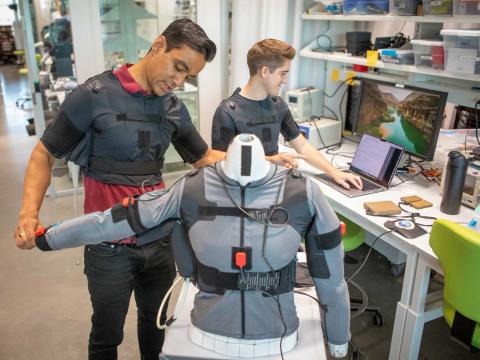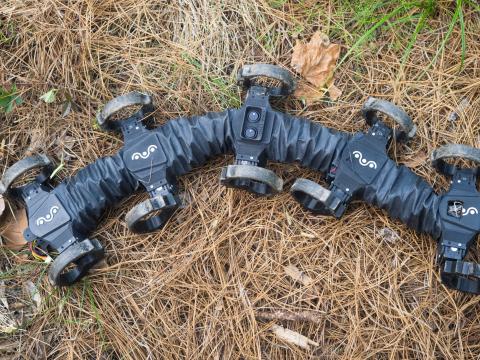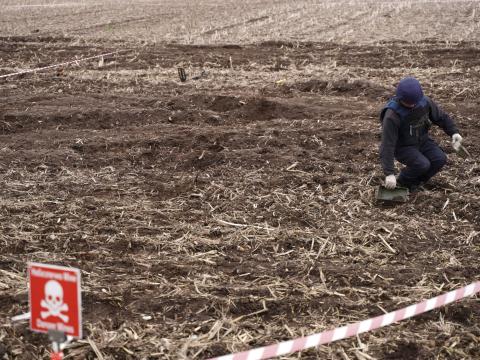Meet MilliMobile, the Mighty Mini-Bot
The MilliMobile can carry three times its own weight in sensors, but it’s not the mini-robot’s strength that makes it special. It’s the power.
Instead of wires or batteries, the fully autonomous, self-driving MilliMobile draws power from either light or radio frequency waves, whichever is most convenient. And both power sources can be either natural or technological.
MilliMobile is about the size of a penny, weighs about the same as a raisin and can move about 30 feet in an hour even on a cloudy day. It uses a light sensor to move automatically toward light sources, so it can run indefinitely on harvested power. “These devices can continue to roll until the wheels fall off or someone steps on it because they didn’t see it,” Kyle Johnson, a University of Washington doctoral student who helped develop the bitty bot, told SIGNAL Media.
The team of University of Washington researchers presented their research at the 29th Annual International Conference on Mobile Computing and Networking and published their paper in the conference proceedings.
Inspired by intermittent computing, which breaks complex programs into small steps so that a device with very limited power can work incrementally as energy is available, the research team equipped MilliMobile with a solar panel-like energy harvester and built the system to move in discrete increments using small pulses of energy to turn its wheels, they explain in a press release.
With intermittent computing, a microcontroller operates for only a short time, within a single second, and then “sleeps” for the remainder of that time, dramatically reducing power consumption, Johnson noted. “That was where we came up with that idea of intermittent motion, where maybe the device for most of the time is sitting and charging up within a second, but then at the end of that second, maybe it uses that energy to convert it into one large burst, and then repeats that process, so that you have something that looks near continuous, instead of being actually continuous.”
This is the first time a robot of such small size has been freed from both tethers and batteries, the researchers contend. “There’s lots of approaches that people have used to make these small insect-scale robots, but they’re not able to operate autonomously or untethered,” Johnson said.
Vicente Arroyos, a University of Washington doctoral student who helps lead the research, suggested in the same interview that MilliMobile takes a major step toward making a reality of science fiction. “Small robots at this scale have been depicted in wider media, like movies and TV. But what I think that people haven’t realized is that these robots don’t exist in the real world.”
The system might conduct search and rescue missions. “Search and rescue was one of the applications we were looking for. Current drones and other robots that are used can actually cause harm if they malfunction or fall off of a cliff or don’t operate the way that they’re supposed to, like a drone falling out of the sky. They weigh so much that they’re actually dangerous to operate around when they malfunction,” Johnson asserted. “With some of these smaller devices, you can send them out in these large deployments, and if there is some kind of crazy environment—like you get in a disaster recovery or something like that—they’re not actually causing any harm to the people around because they’re so small.”
He added that working on “localization technology” will help with the search and rescue mission or locating objects of interest. “If we get some kind of detection for a person here or something of interest, knowing exactly where that is in 3D space is going to be really helpful for locating people and retrieving the device and whatever it was seeking out.”
The research is partially funded by NASA, along with the National Science Foundation and other organizations, so the system also could be used for space exploration. “If they have a larger rover, that can disperse these smaller robot rovers out in the area to survey larger areas much more quickly with a swarm of MilliMobiles. And then they can be retrieved easily to gather that information,” Arroyos said.
Or they could complement NASA satellite data with terrestrial data. Some NASA satellites sometimes monitor the environment, providing information on crop health, for example, Johnson noted. “Having sensors that could deploy themselves helps get your ground data that you can combine with satellite data to get more accurate and more granular readings.”
The researchers also envision swarms of MilliMobiles inspecting infrastructure, such as inside pipes or tubes. Arroyos described the MilliMobile version used for the recently published research paper as having been “souped up” with photovoltaics or photon sensors to detect light, as well as a temperature and humidity sensor. “We could see this being dispersed in infrastructure where you’re trying to detect gas. There’s been interest because of its small size to potentially put it into some tubes and detect corrosion in these larger infrastructure scenarios,” he said.
Johnson added that the systems will be more effective in large numbers. “You can think of having swarms of them that can more quickly go and detect a gas leak or detect other types of electromagnetic waves. And when you’re in these environments, maybe even outdoors or on a smart farm, where you have more light or more of these RF [radio frequency] signals, that just ends up boosting the amount of energy harvested by the device. We’ve designed it to work indoors for some of those indoor applications, but then it can perform even better outdoors when it has more energy to harvest.”
For the swarm concept to work, the researchers need to improve the onboard computing and localization capabilities. “Making sure that we know where these robots are in the environment is the first challenge. People have actually been able to localize larger scale robots in an environment pretty easily, using all kinds of computing and algorithms, but it hasn’t been done at this scale for these robots,” Arroyos stated. “To do that, we need algorithms that are more energy efficient, that don’t use as much of the energy that we’ve harvested on board and are able to do it on these small microcontroller chips that we have put on our robots. Figuring that out is actually another research challenge we’re trying to tackle.”
The system has been tested on 10 types of terrain, including concrete, gravel, compacted dirt and carpet. The intent is to ensure it can operate on a variety of surfaces in unknown environments. “We’re really trying to push these devices to be autonomous in unknown environments. In a lot of these more realistic scenarios, we saw that, yes, it did have an impact on the speed of the device, but it was still able to be mobile over them,” Johnson reported. “What we’re looking into now is multimodal devices.”
With multiple mobility modes, a larger rover could deploy whichever mini-robot system is best suited for the terrain, he elaborated. “We’re looking to leverage different modes of locomotion and then having these swarms of devices to send wherever they’re best fit to disperse and look over that area.”
While MilliMobile’s energy-harvesting approach could be adapted for other platforms, it is best suited for small systems. “We do see the potential for the energy-harvesting capabilities to be used on other platforms. It just really lends itself to this small scale because you require less energy to store up into your battery-less system. It takes less time to store that energy up and to get more motion,” Arroyos said. “On a larger scale, it just doesn’t make as much sense, especially when you have much more powerful motors and actuators that can benefit from batteries.”
The researchers intend to keep improving the technology, but it could be deployed now for some situations. “Depending on the application scenario, there might be use cases for it today,” Johnson offered. “If you think about some of these hydroponic farms that are indoors, they have very consistent grounds that these devices would be able to move over. They have very consistent lighting because the plants need those.”
Because the sensors in smart farms are often fixed, they can be less effective and affect plant health, Johnson suggested. “If one side of the plant is getting more light than the other, or the soil on one side is getting more water, having these devices that can move around and get you more readings and be deployed in larger numbers would be really helpful.”
The “aha!” moment that led to MilliMobile came during research on an origami microflyer. “Looking at all the components and the parts we had in a lab, we noticed that we might be able to make something like a small car, and what sparked the idea of the MilliMobile project was realizing that the same microcontroller we used in the previous project actually took and consumed about the same amount of power to run continuously as some of the really small, eccentric rotating mass motors that you’ll find in phones for, like, helping make them buzz,” Johnson recalled.
The team is applying for patents, and although both Arroyos and Johnson are interested in entrepreneurship, they likely will not appear on the “Shark Tank” TV show in the near future. “We currently are simply working on making sure that we patent all of the research ideas that we’re pushing out. Vicente and I both have entrepreneurial interest, but we’ve been advised to graduate from our Ph.D. programs before we pursue those,” Johnson reported. “We’re definitely open to having other companies and folks reach out to us as far as helping use the technology, sharing ideas, or if they’re wanting to support us as we continue to look more and more into the tech startup world as we get closer to graduating.”
Research Team Members
The MilliMobile research paper recently presented at the 29th Annual International Conference on Mobile Computing and Networking involved six University of Washington researchers.
They are:
- Kyle Johnson
- Zachary Englhardt
- Vicente Arroyos
- Dennis Yin
- Shwetak Patel
- Vikram Iyer
Funding for the research project was provided by:
- Amazon Research Award
- Google Research Scholar Program
- National Science Foundation Graduate Research Fellowship Program
- National GEM Consortium
- Washington NASA Space Grant Consortium
- Pastry-Powered T(o)uring Machine Endowed Fellowship
- SPEEA ACE fellowship program





Comments